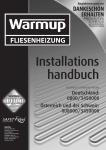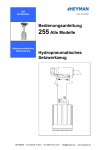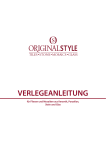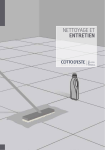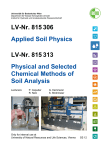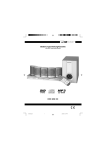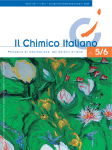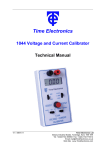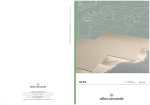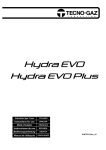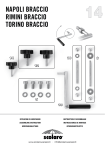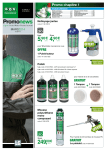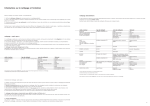Download caratteristiche
Transcript
caratteristiche tecniche spessori technical characteristics . caractéristiques techniques . technische daten . thickness. épaisseur. Stärke. Quando si progetta una pavimentazione industriale, il requisito basilare è la capacità di sopportare carichi statitici e dinamici che possono raggiungere livelli elevatissimi. La piastrella diventa l’elemento portante e il suo spessore gioca un ruolo fondamentale. I pavimenti Cercom sono prodotti in 6 diversi spessori: 8 mm - 9 mm - 10 mm - 11 mm - 12 mm - 14 mm e in 10 formati che vanno da 45x90 cm a 10x10 cm. Consentendo così al progettista grande versatilità d’impiego in ogni tipo di ambiente. The main characteristic of a porcelain tile for a commercial and industrial flooring is the capacity of the tile itself of taking static and dynamic weights that in certain situation could be extremely high. The porcelain tile is in direct contact and the thickness becomes a key factor. Cercom’s porcelain tile are produced in 6 different thicknesses: 8 mm - 9 mm - 10 mm - 11 mm - 12 mm - 14mm and in 10 different sizes, from 45x90 cm - 18”x36” to 10x10 cm - 4”x4”. The intention is to offer a wide range of solution suitable for any kind of project. Dans un projet de carrelage industriel, une caractéristique fondamentale est la capacité de supporter les chargements statiques et dynamiques, même à des niveaux très élevés. Le carrelage devient l’élément portant et son épaisseur joue un rôle fondamental. Les produits Cercom sont réalisés dans six épaisseurs différentes: 8 mm - 9 mm - 10 mm - 11 mm - 12 mm - 14 mm et dans des formats entre le 45x90cm et le 10x10cm. Une gamme considérable qui donne au auteurs des projets grande souplesse d’emploi dans toutes les typologies d’applications. Die wichtigste Eigenschaft eines industriellen Bodenbelages ist sene Biegefestigkeit und Bruchlast. Die Fliese ist das Hauptelement und ihre Staerke ist sehr wichtig. Cercom Fliesen werden in 6 unterschiedliche Staerken produziert: 8 mm, 9 mm, 10 mm, 11 mm, 12 mm, 14 mm und in 10 unterschiedliche Formate von 45/90 cm bis10/10 cm. Der Architekt kann somit immer die richtige Fliese aussuchen. CARICO DI ROTTURA. Breaking of rupture. Charge de rupture. Bruchkraft. Нагрузка KG 800 8 mm . ” 5/16 9 mm . ” 3/8 10 mm . ” 7/16 R9 R 9 R 10 R 9 R 10 11 mm . ” 7/16 12 mm . ” 1/2 14 mm . ” 9/16 R 9 R 10 R 9 R 10 R 9 R 10 700 600 500 400 300 200 0 8 mm 136 9 mm 10 mm 11 mm 12 mm 14 mm superfici surfaces. surfaces. Oberflächen. Cercom, nell’intento di fornire prodotti adeguati ad ogni tipo di ambiente, produce una vasta gamma di superfici in grado di rispondere ad ogni condizione e necessità d’impiego. Oltre alle superfici classiche, vengono prodotti pavimenti antisdrucciolo sia con la tecnica delle applicazioni superficiali di smalti adeguati, che tramite l’utilizzo di idonei stampi strutturati. Inoltre per ottemperare alla richiesta in tema estetico si forniscono prodotti levigati e/o lappati o con superfici che per loro natura creano disegni o forme esteticamente apprezzabili. Cercom is producing porcelain tiles with a wide range of surfaces studied on purpose for every use and condition, in order to be suitable for any kind of project. Beside standard surfaces, Cercom is producing antislip surfaces using superficial and appropriate applications or using directly structure molds during production. In order to achieve high aesthetic requirements Cercom is offering also polished, honed and special finishes that makes porcelain tiles extremely appealing and in line with current trends. L’usine Cercom, afin de fournir des produits appropriés à tous les niveaux d’application, réalise une grosse gamme de surfaces différentes capable de satisfaire toutes les nécessités d’emploi. En plus des surfaces classiques, nous réalisons des finitions anti-slip (ou antidérapantes) aussi bien avec l’application de traitements de produits appropriés qu’avec l’utilisation de moules structurés. Encore, afin d’enrichir le niveau esthétique de la gamme des produits et les choix disponibles, nous fournissons aussi des finitions polis et semi polis (ou adoucis). Da sehr unterschiedliche Einsatzbereiche gibt, produziert Cercom mehrere Oberflächen. Es werden klassische Oberflächen und rutschfeste Oberflächen produziert, entweder mit rutschfesten Glasuren oder mit strukturierten Stempeln. Fuer aestetisch hoehe Ansprueche werden polierte oder angeschliffene Oberflächen angefertigt. SUPERFICIE NATURALE R9 / R10 SUPERFICIE R11 SUPERFICIE LAPPATA SUPERFICIE LEVIGATA SUPERFICIE STRUTTURATA R11 / R12 V4 SUPERFICIE GRAFFIATA R11 SUPERFICIE BOCCIARDATA R11 Crystal Design Evolution Genesis Genesis Loft Geo Habita Home Design Khymeia Roubaix Timeless Stone Crystal Geo Granigliati Habita Home Design Crystal Habita Khymeia Timeless Stone Design Evolution Lapilli Granigliati Home Design Roubaix Home Design Timeless Stone 137 caratteristiche tecniche technical characteristics . caractéristiques techniques . technische daten . SCIVOLOSITA’ La resistenza allo scivolamento è una caratteristica che ricade su sicurezza e salute degli utilizzatori, ovviamente nel caso di pavimentazioni. Le superfici scivolose sono potenziali cause di infortuni, anche gravi sia in ambito civile che negli ambienti di lavoro. La grandezza che quantifica la resistenza allo scivolamento è il coefficiente di attrito (statico o dinamico), al quale è proporzionale la forza, parallela alla superficie di contatto, che occorre applicare perchè si abbia moto relativo tra due corpi, e quindi anche la forza che ne definisce le condizioni di equilibrio. Quanto più alto è il coefficiente di attrito, tanto minore è la scivolosità. Attualmente non è disponibile un metodo di misura standardizzato a livello internazionale, la maggior parte delle nazioni ha metodi propri derivati da leggi, disposizioni antinfortunistiche o altre regolamentazioni di carattere nazionale. Per aver un buon risultato, il valore medio del coefficiente di attrito dinamico deve essere: µ>0,40, R≥R9 e µ≥A. Qui di seguito riportiamo la sintesi degli indicatori che misurano la resistenza alla scivolosità: R: indica l’angolo di inclinazione raggiunto nel test di prova V: rappresenta lo spazio di deflusso determinato dai rilievi della superficie A.B.C. : sono riferimenti di resistenza alla scivolosità relativa ad ambienti umidi e a piedi nudi. SLIP RESISTANCE Slip resistance is a characteristic that affects the health and safety of users in the case of flooring. Slippery surfaces are potential causes of accidents, even serious ones, in civil and work environments. The value that measures slip resistance is the coefficient of friction (static or dynamic); the force required for the relative movement between two bodies (and therefore also the force defining the equilibrium condition), the said force being parallel to the contact surface, is proportional to the coefficient of friction. The higher the coefficient of friction, the less slippery is the surface. An international standardised measurement is not currently available and most countries have their own measurement methods based on laws, accident prevention regulations or other national regulations. For a good result, the average dynamic coefficient of friction should be: µ>0.40, R≥R9 and µ≥A. Here below a short description of the indicators to measure slip-resistance: R: angle of slope achieved during testing V: Downflow space calculated from the surface relief pattern A.B.C. : slip resistance indicators for walking in humid areas. 138 R9 R10 R11 Oltre 6° e fino 10° Oltre 10° e fino 19° Oltre 19° e fino 27° R12 R13 Oltre 27° e fino 35° Oltre 35° V4 V6 V8 V10 cm3/ dm2 4 cm3/ dm2 6 cm3/ dm2 8 cm3/ dm2 10 GLISSANCE La résistance à la glissance du carrelage est une caractéristique très importante pour la sécurité et la santé des utilisateurs et des professionnels pendant la pose du matériel. Les surfaces glissantes sont potentiellement cause d’accidents, même graves, dans le niveau civil comme professionnel. La grandeur qui quantifie la résistance au glissement est le coefficient de frottement (statique ou dynamique), qui est proportionnelle à la force, parallèle à la surface de contact, qui devrait être appliquée, car il ya du mouvement relatif entre les deux organes, et donc aussi la force qui définit les conditions d’équilibre. Plus le coefficient de frottement est grand, moins importante sera la glissance. Actuellement, il n’existe aucune méthode normalisée de mesure de niveau international, la plupart des nations ont leurs propres méthodes dérivées de lois, règles ou règlements de prévention de caractère national. Pour un bon résultat, la valeur moyenne du coefficient de frottement dynamique, devrait être: µ>0,40, R≥R9 e µ≥A. Voici un résumé des indicateurs qui mesurent la résistance à la glisse: R: indique l’angle d’inclination mesurée avec le test. V: mesure la capacité d’évacuation des liquides dérivant de la structure du carreau. A.B.C.: sont des valeurs de resistance à la glisse relatives aux niveaux humides et à pieds nus. RUTSCHIGKEIT Natürlich ist die Rutschfestigkeit eine Eigenschaft, die sich im Bereich der Bodenbeläge auf die Sicherheit und Gesundheit der Anwender auswirkt. Rutschige Oberflächen sind mögliche Ursachen für unter Umständen auch schwere Unfälle sowohl im zivilen Bereich als in der Arbeitsumgebung. Die Größe, die die Rutschfestigkeit misst, ist der Reibungskoeffizient (statisch und dynamisch). Zu diesen verhält sich die Kraft proportional, die parallel zur Kontaktfläche wirkt und angewandt werden muss, damit eine relative Bewegung zwischen zwei Körpern erfolgt. Somit ist sie auch die Kraft, die die Bedingungen für das Gleichgewicht bestimmt. Je höher der Reibungskoeffizient ist, umso niedriger ist die Rutschigkeit. Derzeit steht auf internationaler Ebene keine standardisierte Messmethode zur Verfügung. Der Großteil der Länder besitzt eigene Methoden, die auf Gesetzen, Unfallschutzbestimmungen oder anderen Regelungen nationaler Art beruhen. Um ein gutes Ergebnis zu erzielen, muss der durchschnittliche Wert des dynamischen Reibungskoeffizienten betragen: µ>0,40, R≥R9 und µ≥A. Nachfolgend führen wir eine Zusammenfassung der Indikatoren auf, mit denen die Rutschfestigkeit gemessen wird: R: gibt den beim Test erreichten Neigungswinkel an V: bezeichnet den durch die Vorsprünge der Oberfläche bestimmten Abflussraum A.B.C. : sind Bezüge der Rutschfestigkeit hinsichtlich Feuchträume und Füße O A B C < 12° ≥ 12° ≥ 18° ≥ 24° 139 posa e pulizia CONSIGLI PER LA POSA La totale riuscita di un pavimento in gres porcellanato di Cercom è dovuta, oltre alle qualità tecniche e estetiche del materiale, a un insieme di elementi (sottofondo, strato legante, giunti di dilatazione, ecc.) che costituiscono un vero e proprio sistema. Anche le operazioni di posa, eseguite nella loro corretta successione, sono da considerare importanti tanto quanto la scelta delle piastrelle. Nella scelta dell’adesivo più indicato e per le modalità di applicazione si consiglia di attenersi alle istruzioni della azienda produttrice del collante stesso. È importante, inoltre, controllare che i prodotti da utilizzare per la stuccatura, se molto colorati, non sporchino le superfici delle piastrelle e che tale sporco sia facile da asportare: si consiglia pertanto di effettuare una prova prima di dare inizio alla stuccatura. Per qualsiasi chiarimento e/o informazione si suggerisce di consultare la divisione tecnica Cercom, soprattutto se il materiale dovrà essere posato in particolari condizioni ambientali. Il progetto di ogni superficie piastrellata deve essere affidato a un esperto progettista che, in funzione della struttura, della destinazione d’uso degli ambienti, dei carichi previsti e delle sollecitazioni meccaniche, termiche, fisiche e chimiche che graveranno sulla pavimentazione, deve dimensionare sottofondi, strati cementizi, allettamento, piastrelle ceramiche, pendenze e tutto il sistema di posa. Inoltre, il progettista deve fissare nel capitolato di posa ogni specifica di cantiere, tra cui tipo e modalità di posa, materiali, granulometrie, dosaggi, dimensioni delle fughe, giunti strutturali, di dilatazione, perimetrali, ecc. OPERAZIONI DI POSA 1. Scegliere accuratamente i requisiti estetici e tecnici delle piastrelle (in relazione allo stile e alla destinazione d’uso degli ambienti), i formati da posare, lo schema di posa, le dimensioni e il colore delle fughe. 2. La posa senza fuga è fortemente sconsigliata, addirittura non praticabile per ambienti esterni. Nel caso di posa modulare di diversi formati, prevedere fughe di: 2 o 3 mm per i prodotti rettificati; 4 o 5 mm per i prodotti NON rettificati. 3. Comunicazioni al momento dell’ordine: specificare sempre se il materiale richiesto è destinato alla posa in multiformato, per permettere agli uffici commerciali di spedire ai clienti il materiale con calibri e tonalità abbinabili. 4. Il gres porcellanato Cercom può essere posato sia con malta tradizionale sia con adesivo. 5. Eseguire la posa “a regola d’arte”, seguendo le indicazioni del progettista, del responsabile di cantiere e del capitolato di posa. 6. Per la migliore gestione del cantiere è fondamentale rispettare bene i tempi di lavorazione dei materiali utilizzati, seguendo le indicazioni dei produttori. 7. Controllare i materiali prima della posa. Reclami su materiale già posato non saranno accettati. 8. Stendere a terra alcuni metri (almeno 3 mq) per controllare l’effetto d’insieme. Posare il materiale attingendo da più scatole controllandone accuratamente calibro, tonalità e scelta. 9. L’alto grado di greificazione delle piastrelle di Cercom comporta modeste tolleranze di calibro, pertanto, nella posa, è consigliabile lasciare una fuga almeno di 3 mm fra le piastrelle. 10. Non segnare la parte superiore con matite o pennarelli. 11. Attendere 48/72 ore prima di sottoporre il pavimento al normale transito. Le variazioni cromatiche del prodotto sono una caratteristica qualificante che l’abilità del posatore può valorizzare. Un bel prodotto posato male non dà un buon risultato estetico. 12. Posa consigliata con una sfalsatura tra ciascun listello non superiore al 25% della lunghezza. CONSIGLI PER LA POSA DEL RETTIFICATO La posa del prodotto rettificato a giunto accostato, non unito, richiede una maggiore attenzione e precisione da parte dell’installatore sia per quanto riguarda la planarità del piano di posa sia per la continuità delle fughe. Per un effetto ottimale della posa, Cercom suggerisce di mantenere almeno 1 o 2 mm di fuga per pose monoformato e 2 o 3 mm per combinare formati misti. La posa a giunto unito, soprattutto nei grandi formati, è fortemente sconsigliata dai maggiori produttori di collante per i seguenti motivi: • difficoltà di assorbimento di eventuali movimenti strutturali in assenza di elementi comprimibili; • diverso comportamento dilatometrico fra piastrelle e massetto, in presenza di elevate escursioni termiche; • difficoltà di realizzo di una duratura e efficace stuccatura. Cercom sconsiglia assolutamente pose senza fuga, per le quali si declina ogni responsabilità. Cercom suggerisce pose del rettificato con fughe minimo di 1 o 2 mm. STUCCATURA 1. Qualora non si utilizzasse la boiacca composta da cemento e sabbia, si consiglia di utilizzare colori di stucco su tono (possibilmente non utilizzare su materiali di colore chiaro stucchi di colore scuro, tipo nero, blu, rosso). 2. Riempire le fughe con gli stucchi solo quando il pavimento è pedonabile, togliendo preventivamente dalle fughe ogni tipo di residuo. 3. Eseguire la stuccatura a “regola d’arte”, seguendo le indicazioni del progettista, del responsabile di cantiere e del capitolato di posa. 4. Stuccare piccole superfici per volta (4/5 mq) e asportare le quantità eccedenti con spugne o stracci umidi (di sola acqua pulita) o utilizzare apposite macchine per togliere lo stucco eccedente. 5. Stucchi cementizi non additivati: a fine giornata pulire i residui di posa con spugna appena bagnata. Salvo diversa indicazione del fabbricante, la pulizia dopo la posa della pavimentazione deve essere effettuata dopo 4-5 giorni (per permettere il necessario indurimento degli stucchi delle fughe), bagnando prima le fughe con acqua, poi utilizzando appositi detergenti a base acida. Non attendere troppo per effettuare tale pulizia, già dopo due settimane diventa molto laboriosa. Non effettuare la pulizia dopo la posa se la temperatura delle piastrelle è elevata; in estate, effettuarla nelle ore fresche della giornata. 6. Stucchi epossidici o additivati (con lattici, ecc.): seguire attentamente le indicazioni dei fabbricanti, perché il loro rapido indurimento può richiedere pulizie molto laboriose, specialmente se la superficie delle piastrelle è antiscivolo, ruvida o strutturata. PULIZIA, TRATTAMENTI PROTETTIVI E DI ROUTINE DELLE PIASTRELLA IN PORCELLANATO La durata di una superficie piastrellata dipende anche dal modo in cui viene usata e mantenuta. Pavimenti e rivestimenti progettati e posati correttamente, rappresentano superfici assai resistenti. Tuttavia sono necessarie alcune precauzioni dettate dal buon senso, oltre che dalla conoscenza delle caratteristiche dei materiali. LAVAGGIO DOPO POSA Il lavaggio dopo posa è una fase di fondamentale importanza per tutti gli interventi successivi e per la manutenzione. Con il lavaggio acido dopo posa si eliminano i residui di posa e il normale sporco di cantiere come: malta, colla, pittura, sporco da cantiere di varia natura. E’ bene sapere che oltre il 90% delle contestazioni in cantiere è dovuto ad un cattivo, o addirittura inesistente, lavaggio con detergente acido dopo posa. Per evitare che un prodotto a base acida usato per la prima pulizia vada ad intaccare il riempimento a base cementizia delle fughe, è necessario, prima dell’operazione di pulizia, bagnare il pavimento affinché le fughe vengano impregnante e pertanto protette dall’azione corrosiva dell’acido stesso. 140 Se la prima pulizia deve essere fatta poco dopo che il pavimento è stato usato, è opportuno: • prima togliere con appositi detergenti a base alcalina sostanze grasse o simili • poi procedere al lavaggio dopo posa Dopo la pulizia occorre risciacquare abbondantemente il pavimento, raccogliendo l’acqua residua. La pulizia di fine cantiere si esegue a completa stagionatura dello stucco cementizio (almeno 48-72 ore), attenendosi scrupolosamente ai consigli riportati dal produttore di detergenti. La pulizia di fine cantiere fatta con prodotti a base acida tamponati, quali ad esempio Deterdek di Fila, Keranet di Mapei, Delta Plus di Kerakol o Cement Remover di Faber o Bonaclean, Bonamain+, Bonaconcrete di Bonasystem, va eseguita una sola volta e presenta l’ulteriore vantaggio di conferire uniformità cromatica alla superficie. Come strumento per il lavaggio vi consigliamo MagicClean di Bonasystems. MANUTENZIONE ORDINARIA Si consiglia l’utilizzo di un comune detergente neutro diluito in acqua. Evitare l’utilizzo di prodotti acidi, alcalini, ceranti e/o impregnanti. Nella pulizia ordinaria occorre limitare al massimo l’uso di mezzi abrasivi (ad esempio: paglietta di metallo, spugnette di ferro o acciaio). Questa precauzione diventa un obbligo nel caso di piastrelle con superficie lucida, più esposte ad effetti visibili di scalfitture, graffi,… Come strumento per il lavaggio vi consigliamo MagicClean di Bonasystems. In caso di sporchi più intensi o di superfici particolarmente strutturate, usare un detergente a base alcalina risciacquando al termine del lavaggio. Per le grandi superfici è consigliabile l’utilizzo di macchine . Nella pratica quotidiana occorre considerare che certi tipi di sporco (polvere, sabbia) aumentano l’effetto abrasivo del traffico pedonale. Cercare quindi di prevenire la presenza di questo tipologia di sporco dall’esterno, predisponendo l’utilizzo di zerbino o stuoino all’ingresso. MANUTENZIONE STRAORDINARIA Nel caso di tracce di sporco resistente alla pulizia ordinaria, si raccomanda l’utilizzo di un detergente adeguato in funzione del tipo di sporco. PAVIMENTI E RIVESTIMENTI METALLIZZATI Per la pulizia e manutenzione di piastrelle metallizzate si raccomanda di non usare assolutamente detergenti acidi o alcalini. Usare esclusivamente prodotti con PH neutro come ad esempio Fila Cleaner o Floor Cleaner di Faber o Bonadecon, Bonamain+ di Bonasystems. In ogni caso verificare sempre prima il prodotto su porzione di materiale non posato ed evitare di lasciare il detergente sulle piastrelle per più di 10 – 15 min. Risciacquare sempre abbondantemente con acqua. RACCOMANDAZIONI Per ultimo ricordiamo di non usare mai detergenti a base di acido fluoridrico (HF) o dei suoi composti, compresi antiruggine o smacchiatori tipo spray che spesso lo contengono. Il danno che si potrà provocare sarà irreparabile in quanto non esiste pavimento sul mercato resistente a tale acido. AVVERTENZE Le caratteristiche di pulizia dei materiali variano in modo significativo per le diverse modalità di installazione, condizioni d’uso, tipologie di superfici e ambiente. In linea generale all’aumentare delle caratteristiche di antiscivolosità delle piastrelle, aumentano le difficoltà di pulizia. L’operatore professionale incaricato dell’intervento di manutenzione e pulizia, dovrà sempre procedere ad una preliminare verifica empirica, possibilmente su una porzione di materiale non posato, per ogni singolo tipo di intervento. In caso di condizioni d’uso particolarmente gravose, di errata installazione o di pulizie effettuate in modo inadeguato Serenissima Cir Industrie Ceramiche SpA declina ogni responsabilità in merito all’efficacia delle operazioni di pulizia e manutenzione. Resta inteso che Serenissima Cir Industrie Ceramiche SpA non potrà essere ritenuta responsabile per eventuali danni o difetti dovuti ad errata installazione, negligente pulizia e manutenzione o inadeguata scelta della tipologia dei materiali installati e degli adesivi utilizzati con riguardo alla destinazione. Le indicazioni contenute in questo paragrafo sono puramente indicative. Per notizie più approfondite rimandiamo a documentazione specializzata disponibile su cataloghi e siti web delle principali ditte produttrici di prodotti specifici per la pulizia dei pavimenti quali ad esempio: Bonasystems Italia S.r.l. (www.bonasystemsitalia.it) Fila Industria Chimica spa (www.filachim.com), Faber Chimica srl (www.faberchimica.com), Mapei S.p.A. (www.mapei.it), Kerakoll S.p.A. (www.kerakollgroup.com). TRATTAMENTO PRODOTTI LAPPATI E LEVIGATI Lappatura e Levigatura sono lavorazioni che prevedono l’asportazione e la lucidatura della parte superficiale dello smalto o del corpo stesso della piastrella. In tutti i pavimenti ceramici disponibili sul mercato, tale lavorazione, pur in presenza di materiali vetrosi o a bassissimo assorbimento, può comportare l’apertura di microporosità superficiali che, a contatto con particolari tipi di sporco, possono risultare di difficile pulizia o presentare aloni difficilmente rimuovibili. Serenissima Cir Industrie Ceramiche spa, consiglia, successivamente al lavaggio dopo posa che deve essere effettuato utilizzando un detergente a base acida tipo Deterdek di Fila, Keranet di Mapei, Cement Remover di Faber, Delta Plus di Kerakoll o Bonaclean, Bonamain+, Bona Concrete di Bonasystems, di eseguire una protezione antimacchia con prodotti certificati quali MP/90 di Fila, Gres Protector di Faber o Bonaseal di Bonasystems al fine di impedire che il materiale possa assorbire le macchie mantenendo inalterate le caratteristiche estetiche e tecniche del gres porcellanato. Ricordiamo che qualsiasi trattamento venga effettuato dal produttore pre posa, sarà totalmente asportato dal lavaggio a base acida che dovrà essere effettuato successivamente la posa e quindi nessuna efficacia antimacchia potrà essere garantita. 141 laying and cleaning LAYING SUGGESTIONS The success of a porcelain stoneware floor by Cercom is due to the technical and aesthetical features of the materials as well as to a combination of elements (bed, binding layer, expansion joints, etc.) which build up a real system. The laying operations, carried out in the correct sequence, are also as important as the choice of tiles. When choosing the most suitable adhesive and the application method refer to the instructions of the manufacturer. However, the designers has to establish the correct way of application of the tiles depending on the structure and the foreseen utilization of the floor. The design of all tiled surfaces should be entrusted to an expert designer, who must calculate the dimensions of the sub-base, the cement-based layers, the bedding layer, the falls and the entire laying system, taking into account the structure, the intended use of the spaces, the expected loads and the mechanical, thermal, physical and chemical stresses which will impact on the tiled surface. The designer must also determine in the laying specification every detail of the site, including type and method of laying , materials, particle size, mixing proportions, size of joints, location of structural, expansion and perimeter joints, etc. LAYING OPERATIONS 1. Carefully choose the aesthetic and technical requirements of the tiles (in relation to the style and intended use of the spaces), the tile formats to be used, the laying scheme, and the width and colour of the joints. 2. Laying edge-to-edge without joints is strongly discouraged, indeed it is not practicable for exterior applications. In the case of modular laying of different formats, allow the following joint widths: 2 or 3 mm ”1/16 or ”1/8 for rectified products; 4 or 5 mm ”3/16 or ”3/16 for NON-rectified products. 3. Notification at time of ordering: always specify if the material requested is intended for multiformat laying to allow our sales office to send the client material with matching gauges and colouring. 4. Cercom stoneware tiles may be laid with traditional mortar or with adhesive. 5. Carry out laying to a professional standard, following the instructions of the designer, the site manager and the laying specification. 6. For best management of the site, it is essential to pay careful attention to the working times of the materials used, and follow the manufacturer’s instructions. 7. Check materials before they are laid-out. Claims on materials already installed will not be accepted. 8. Lay some pieces of product (at least 3 sqm) to check the overall effect. Lay the material taking it from several boxes and carefully check its size accuracy, shade and material sorting. 9. The hight level of vitrification belonging to group Cercom tiles bears modest caliber tolerances, therefore in the lay-out is advisable to leave at least 3 mm 1/8” grout line between each tile. 10. Do not mark the upper part with pencils or felt pens. 11. Wait 48/72 hours before walking on the floor. A fine product laid in a bad way will not yield good aesthetic results. 12. When laying, you are recommended not to stagger the strips by more than 25% of the lenght. GUIDELINES FOR LAYING RECTIFIED MATERIALS Installation of ground, closed-joint products requires the installer’s full attention, with special reference to the level of the laying plane and to the continuity of the joints. For optimal installation results, Cercom recommends maintaining a joint at least of 1 or 2 mm - ”1/16 or ”1/16 for single format installations and 2 or 3 mm - ”1/16 or ”1/8 to combine mixed formats. No joint setting, especially in large size product, is strongly advised against by all major adhesive producers for the following reasons: • difficulty in withstanding possible structural movement due to lack of joint; • different shrink/expand behaviour, in case of high thermal excursion; • difficulty in obtaining an effective and long lasting grouting. Cercom does not recommend closed joint tiling and is not liable if this method is employed. Cercom recommends a minimum 1 or 2 mm - ”1/16 or ”1/16 joint when tiling with rectified edge tiles. GROUTING 1. If the cement and sand grout is not used, it is advisable to use grout with the same colour shades (it is preferable not to employ dark grout such as black, blue, red grout on light-coloured materials). 2. Fill the joints with grout only when the floor can safely be walked on, having first removed all kinds of residue from the joints. 3. Carry out grouting to a professional standard, following the instructions of the designer, the site manager and the laying specification. 4. Grout small surfaces at a time (4/5 sqm) and remove the exceeding amounts by means of sponges or wet cloths (with clean water only) or use suitable machines for removing the excess grout. 5. Cement-based grouts without additives: at the end of the day, clean off the grout residue with a slightly damp sponge. Unless otherwise indicated by the manufacturer, “after-laying” cleaning if the flooring should be carried out after 4-5 days (to allow the necessary hardening of the grout, in the joints), by first wetting the joints with water, then using suitable acid-based detergents. Do not wait too long before carrying out this cleaning: after two weeks it already becomes too laborious. Do not do “after-laying” cleaning if the temperature of the tiles is high: in summer, do it in the cool hours of the day. 6. Epoxy grouts and grouts containing additives (with latex etc.) follow the manufacturer’s instructions carefully, because the rapid hardening of these grouts can necessitate very laborious claning, especially if the tiles have a rough, anti-slip or structured surface. CLEANING-PROTECTION AND ROUTINE CARE OF PORCELAIN TILES The first cleaning after the tiles installation will influence the cleanability of the surface for its entire life. Floors and wall installations well planned and correctly layed represent very durable surfaces. Common-sense precautions are nevertheless necessary, as well as a good technical knowledge of the materials. CLEANING AFTER LAYING The cleaning after laying is an extremely important phase from which depends all the future applications and the maintenance of the floor. With an acid base cleaning after the floor installation it is possible to remove the regular dirt that can be found on the jobsite: cement, glue, paint stains... It is worth to know that more than 90% of the claims is due to a not proper cleaning after laying with acid base detergent. Sometimes this phase is even missing. Before cleaning an installed floor with an acid base product it is strongly suggested to pour water on the surface in order to wet the grout joint and protect them from the corrosive action of the acid. Otherwise it may happen that the acid solution included in the cleaning product could erode the grout. In case the first cleaning is made after the floor has been used, it is necessary to remove the dirt that could be found on the floor using alkaline based product, and then proceed with the post laying cleaning. After this process it is necessary to profusely pour water on the floor and, as a final step, remove as much dirty water as possible. The cleaning after laying needs to be done once the grout in the joint is fully dry (48 to 72 hours), properly following the indication of the manufacturer of the 142 cleaning product used. The cleaning after laying made with acid based products such as Fila’s Deterdek, Mapei’s Keranet, Kerakoll’s Deltaplus, Faber’s Cement Remover, Bonaclean, Bonamain+ or Bona Concrete of Bonasystems needs to be done only once and has the advantage of maintaining an uniformity in the colour tone of the entire floor. As a tools of washing, we recommend Magic Clean Bonasystems. ROUTINE MAINTENANCE You are recommended to use ordinary neutral detergent diluted in water. Avoid using acid or alkaline products, waxes and/or impregnants. During ordinary cleaning it is recommended to use extremely abrasive items (such as scourers and iron or steel sponges) as little as possible. This recommendation must be adhered to rigorously in the case of tiles with a glossy surface finishing as they are more susceptible to the risk of scuffs, scratches and loss of shine, etc. As a tools of washing, we recommend Magic Clean Bonasystems. In the event of heavy dirt or particularly textured surfaces, use an alkaline detergent and rinse after washing. For large surfaces, the use of a floor washing machine is recommended. During every-day cleaning procedures, it is necessary to remember that certain types of dirt (dust, sand) increase the abrasive effect of foot-traffic. Therefore we recommend that you avoid bringing in this type of dirt, which comes in from the outside, by placing a door-mat at the entrance. EXTRAORDINARY MAINTENANCE In the event of dirt resistant to the ordinary cleaning, use a suitable detergent for that particular kind of dirt. METALLIZED FLOOR AND WALL TILES For the cleaning and maintenance of the tiles with iridescent metal effect surface it is strictly recommended not to use acid or alkaline detergents. Please use exclusively products with neutral PH like for example Fila Cleaner or Faber Floor Cleaner or Bonadecon and Bonamain+ of Bonasystems. In any case please test each cleaning product in advance, if possible on a piece of the material not laid and avoid to leave the detergent on the tiles for more than 10-15 minutes. Always rinse heavily with water after cleaning. RECOMMENDATIONS Last but not least, please remember never to use stain remover such as anti-rust products or sprays, because they contain hydro-fluoric acid: this would case irreparable damage since no floor tile in the world, whether produced by us or others, withstands this acid. The following are the most suitable cleaning products for the various types of dirt. WARNING The cleaning characteristics of the materials may vary significantly depending on the laying method, conditions of use, type of surface and environment. Generally speaking, the higher the non-slip characteristics of the tiles, the more difficult they are to clean. The maintenance and cleaning operator should always test each cleaning method empirically in advance (if possible on a piece of the material not laid). In the case of particularly heavy use, incorrect laying or inappropriate cleaning, Serenissima Cir Industrie Ceramiche Spa declines all responsibility for the effectiveness of cleaning and maintenance operations. Serenissima Cir Industrie Ceramiche spa can under no circumstances be held responsible for events, damage or defects caused by incorrect laying, negligent cleaning and maintenance or the use of inappropriate materials and adhesives. The information within this paragraph are purely indicative. For more specific information please refer to the proper documentation available on the catalogues and websites of the main cleaning products manufacturers like for example Bonasystems Italia S.r.l. (www.bonasystemsitalia.it) Fila Industria Chimica spa (www.filachim.com), Faber Chimica srl (www.faberchimica.com), Mapei S.p.A. (www.mapei.it), Kerakoll S.p.A. (www.kerakollgroup.com). TREATMENT OF HONED AND POLISHED PRODUCTS Polish and lap are process that foresee the removal and polishing of the superficial part of the glaze or of the tile body. In all glazed floor tiles available in the market, this process, even with vitreous or with very low absorption materials, can involve the opening of superficial micro porosity which, in contact with particular kind of dirtiness, can be hard to clean or present haloes hardly removable. Serenissima CIR industrie ceramiche s.p.a. recommends, after the washing after the laying, that must be made using an acid cleaner like Deterdek of Fila, Keranet of Mapei, Cement Remover of Faber, Delta Plus of Kerakoll or Bonaclean, Bonamain+, Bona Concrete of Bonasystems, to effect an antistain protection with certified products such as MP/90 of Fila, Gres Protector of Faber or Bonaseal of Bonasystems, in order to prevent that the material can absorb the stains maintaining unchanged the aesthetic and technical features of glazed porcelain. We remind you that any treatement the producer maker before laying, will be completely removed by washing at acid base that must be done after the laying and therefore no efficace anti stain can be granted. 143 pose et lavage CONSEILS POUR LA POSE La réalisation optimale d’un carrelage en grès cérame de Cercom est due non seulement aux qualités techniques et esthétiques du matériel, mais aussi à un ensemble d’éléments (fond, couche de liant, joints de dilatation, ect.) constituant un véritable système. Les opérations de pose, exécutées dans la suite exacte, doivent etre considérées importantes comme le choix des carreaux. Pour le choix du produit collant plus convenable et pour les modalités d’application, il est conseillé de se conformer aux instructions fournies par la maison de fabrication du produit collant. Le projet de chaque surface carrelée doit être confié à un expert qui, selon la structure, la fonction, les charges prévues et les contraintes mécaniques, thermiques, physiques et chimiques auxquelles le carrelage sera soumis, établira les consignes en matière d’épaisseur des couches de forme, its de ciment, dés, carreaux, inclinaison et pour tout le système de pose. En outre, l’architecte doit reprendre tous les détails du chantier dans le cahier de charges, notamment le type et le mode de pose, les matériaux, la granulométrie, les dosages, les dimensions des écarts, des joints de structure, les joints de dilatation, les joints périmétraux, etc. MODALITES DE POSE 1. Choisir avec soin les carreaux en fonction des exigences esthétiques et techniques du lieu de pose, le format, le schéma de pose, les dimensions et la couleur des joints. 2. Une pose sans écarts est fortement conseillée même si elle n’est pas recommandées en extérieur. En cas de pose modulaire de plusieurs formats, prévoir des joints de 2 ou 3 mm pour les articles rectifiés; 4 ou 5 mm pour les articles NON rectifiés. 3. À signaler à la commande: toujours indiquer si le matériau désiré est destiné à une pose multiformat afin de permettre aux commerciaux d’envoyer aux clients les calibres et les tons assortis. 4. Les grès Cercom peuvent être posés à l’aide de ciment traditionnel ou de colle. 5. Procéder à la pose dans les règles de l’art en suivant les indications de l’architecte, du responsable de chamtier et du cahier de charges. 6. Pour une meilleure gestion du chantier, il est essentiel de respecter les temps de mise en place des matériaux utilisés en suivant les indications fournies par les fabricant. 7. Controler les matériaux avant la mise en oeuvre. Des réclamations concernant le matériel dejà mis en oeuvre, ne seront pas acceptées. 8. Appuyer sur le sol quelques pieds (au moins 3 mc) pour apprécier l’effet global. Poser le matériel en le prenant de plusieurs boîtes et en contrôlant l’épaisseur, les nuances et la qualité des différentes pièces. 9. La haute degré de greification des carreaux de Cercom comporte une modeste différence de calibre; c’est pourquoi nous conseillons lors de la pose de laisser au moins un joint de 3 mm entre les carreaux. 10. Ne pas marquer la partie supérieure par des crayons ou des feutres. 11. Attendre 48/72 heures avant de transiter sur le carrelage. Les variations chromatiques du produit sont donc un trait distinctif que seul l’habilité du poseur peut valoriser pour créer un carrelage unique et incomparable. Un beau carreau mal posé ne donne pas un bon résultat esthétique. 12. Pose conseillée avec un décalage entre chaque listel non supérieur au 25% de la longueur. CONSEILS POUR LA POSE DES MATERIAUX RECTIFIES La pose du produit rectifié sans joint demande une très grande attention et précision de la part de l’installateur pour ce qui est de la planéité du plan de pose et pour la continuité des joints. Pour réaliser une pose parfaite, Cercom suggére de mantenir au moins 1 ou 2 mm de joint pour la pose des monoformats, et 2 ou 3 mm pour les combinaisons de formats mixtes. La pose sans joint, surtout pour ce qui concerne les grands formats, est fortement déconseillée par la plupart des producteurs de colle, pour les motifs suivants: • difficulté pour absorber les éventuels mouvements du carrelage; • dilatation différente entre le carrelage et la chape, en présence de grandes variations de température; • difficulté pour réaliser un joint efficace et durable. Cercom déconseille totalement des poses sans joint. Dès lors, la société ne saurait être tenue pour responsable des conséquences de ce choix. Cercom conseille de faire des joints de 1 ou 2 mm minimum pour poser le produit rectifié. MASTICAGE 1. Si l’on utilise du coulis constitué de ciment et sable, nous conseillons d’utiliser du mastic dans des couleurs ton sur ton (si possible, pour les matériels clairs ne pas utiliser de mastics d’une couleur sombre, telle que noir, bleu, rouge). 2. Mastiquer des petites surfaces (4 à 5 mc) et éliminer les excès à l’aide d’éponges, des chiffons imbibés d’eau propre ou des machines spécialement conçues pour éliminer le mastic en excès. 3. Combler les écarts à l’aide de mastic uniquement lorsque le carrelages est praticable. Veiller à retirer les résidus éventuels des écarts avant de procéder. 4. Procéder au masticage dans les règles de l’art en suivant les indications de l’architecte, du responsable de chantier et du cahier de charges. 5. Enduits de ciment non dopés: à la fin de la journée, nettoyer les résidus de pose à l’aide d’une éponge légèrement humide. Sauf indication contraire du fabricant, le nettoyage du carrelage doit être effectué après 4-5 jours (afin de permettre au mastic de sécher). Il faudra d’abord humidifier les joints avec de l’eau pour ensuite recourir à des détergents à base acide spécialement prévus pour ce type d’utilisation. Ne pas attendre trop longtemps avant de procéder au nettoyage car au bout de deux semaines, il est déjà beaucoup plus d’obtenir des résultats satisfaisants. Ne pas nettoyer après la pose si la température des dalles est élevée. En été, nettoyer au cours de la période la plus fraîche de la journée. 6. Mastics époxy ou dopés (avec latex, etc.): suivre attentivement les indications des fabricants car le durcissement des mastics peut rendre le nettoyage difficile, surtout en présence de carreaux antidérapantes, rugueuses ou structurées. LAVAGE, PROTECTION ET ENTRETIEN DU GRÈS CÉRAME Le soin dans le nettoyage de votre carrelage après la pose influencera la facilité et l’entretien de celui-ci pour toute sa durée de vie. NETTOYAGE APRÈS LA POSE L’importance du nettoyage après la pose est fondamentale pour garantir la qualité de l’entretien et la maintenance future de votre carrelage. Avec un lavage acide après la pose il est possible d’éliminer le résidu de toutes les substances que l’on retrouve habituellement sur un chantier: colle, peinture, ciment, etc. ... Nous vous rappelons que 90% et plus des litiges sur les chantiers sont dus à de mauvaises applications de produits de nettoyage à base d’acides, ou encore à la complète absence de traitements après la pose. Pour éviter que le lavage après la pose à base acide puisse détériorer le ciment des joints, il est nécessaire de mouiller la surface pour permettre l’absorption d’eau et donc la protection contre l’action érosive sur les joints. Si le premier nettoyage après la pose doit être fait après une première utilisation de votre sol sur le chantier, il sera opportun d’éliminer avec des détergents alcalins toutes les traces de graisses ou similaires avant d’appliquer le nettoyage après la pose à base acide. 144 Suite au lavage il faut bien rincer le sol avec de l’eau claire. L’eau doit être récupérée rapidement sur la surface avant qu’elle ne sèche. Le lavage après la pose doit être fait après le complet séchage et stabilisation des joints à base de ciment (au moins 36-48 heures), dans le respect scrupuleux des instructions du mode d’emploi données par le fabricant du détergent. Le lavage après la pose avec des produits à base acide, appliqués à l’éponge, comme le Detertek Fila, Keranet Mapei, Delta Plus Kerakoll, Cement Remover Faber ou Bonaclean, Bonamain+ et Bona Concrete de Bonasystems doit être fait en une seule fois et donne l’avantage d’obtenir aussi une uniformité chromatique du sol. Comme matériel de travail, nous vous conseillons “Magic Clean” de Bonasystems. ENTRETIEN QUOTIDIEN Il est recommandé d’utiliser un produit détergent ordinaire, neutre et dilué dans de l’eau. Eviter toute utilisation d’acides, alcalins, produits de cirage et/ou imprégnants. Lors du nettoyage au quotidien il faut limiter au maximum l’emploi de systèmes fortement abrasifs (comme par exemple, les paillettes métalliques; ou les éponges de fer). Cette précaution devient obligatoire lorsque les carreaux ont une surface brillante , ils sont donc plus exposés aux effets visibles des rayures, des griffes , de l’opacification. Comme matériel de travail, nous vous conseillons “Magic Clean” de Bonasystems. En cas de saleté plus consistante ou de surfaces particulièrement structurées, il est conseillé d’utiliser un produit détergent à base alcaline en prenant soin de bien rincer en fin de lavage. Pour les grandes surfaces, il est recommandé d’utiliser des machines lavantes et séchantes. Dans l’utilisation au quotidien, il faut tenir compte que certaines saletés (poussière, sable) augmentent l’effet abrasif avec le trafic piétonnier. Essayer par conséquent d’anticiper la présence de ce type de saleté, qui provient de l’extérieur, en recourant à l’emploi de tapis brosse à l’entrée. ENTRETIEN EXTRAODINAIRE En cas de saleté résistant au nettoyage ordinaire, il est recommandé d’utiliser un produit détergent adapté au type de saleté plus persistantes. SOLS ET REVÊTEMENTS MÉTALLISÉS Pour le nettoyage et l’entretien des carreaux métallisés il est conseillé de ne pas utiliser des détergents acides ou alcalins. Il faut utiliser exclusivement des produits avec PH neutre, comme par exemple Fila Cleaner ou Faber Floor Cleaner ou Bonadecon et Bonamain+ de Bonasystems. De plus, il faut toujours effectuer un essai sur une portion de matériel non posé et éviter de laisser le détergent sur le carrelage pour plus de 10-15 minutes. Enfin, il faut toujours rincer abondamment avec de l’eau claire. RECOMMANDATIONS Pour finir, il faut se souvenir de ne jamais utiliser des détergents à base d’acide fluorhydrique (HF) ou de ses composés, y compris antirouille ou détachant. Le dommage qui pourrait être provoqué suite à l’utilisation de cet acide sera irréparable, étant donné qu’il n’existe pas de carrelage sur le marché résistant à un tel acide. MISE EN GARDE Les caractéristiques de nettoyage des matériaux peuvent variées de façon significative selon les modalités de pose, les conditions d’utilisation, les types de surfaces et de lieux. Généralement, plus les caractéristiques antidérapantes des carreaux sont élevées, plus le nettoyage est difficile. Avant chaque intervention, l’opérateur professionnel chargé de l’entretien et du nettoyage devra toujours effectuer un contrôle empirique (si possible sur une portion de matériau non posé). Serenissima Cir Industrie Ceramiche Spa décline toute responsabilité quant à l’efficacité des opérations de nettoyage et d’entretien en cas de pose ou de nettoyages non adaptés, ainsi que dans des conditions d’utilisation particulièrement difficiles (par exemple, ateliers de mécaniciens ou dans des endroits avec des résidus huileux importants et des traces de pneus), ainsi qu’en cas de choix erroné pour ce qui concerne la typologie des matériaux installés et des colles utilisées. Tous les renseignements présents dans ce document sont donnés a titre indicatifs. Pour des renseignements plus techniques nous vous recommandons des documentations spécifiques comme les modes d’emploi déjà présentés sur les étiquettes emballages des produits, ou directement chez les fabricants de détergents pour le nettoyage de sol, ou encore sur les sites web des principales sociétés productrices de produits spécifiques pour le nettoyage des sols comme par exemple: Bonasystems Italia S.r.l. (www.bonasystemsitalia.it) Fila Industria Chimica spa (www.filachim.com), Faber Chimica srl (www.faberchimica.com). Mapei S.p.A. (www.mapei.it), Kerakoll S.p.A. (www.kerakollgroup.com). TRAITEMENT DES PRODUITS POLIS ET LEVIGES Le polissage et la lévigation sont des opérations qui prévoient l’enlèvement et l’astiquage de la partie superficielle de l’émail, ou du corps même du carrelage. Dans tous les sols en céramique disponibles sur le marché, une telle opération ; même en présence de matériaux vitreux ou de très basse absorption; peut comporter l’ouverture de microporosité superficielle qui, au contact avec des particules comme la saleté, peuvent résulter de nettoyage difficile ou présenter des auréoles qui s’enlèveront difficilement. Serenissima-CIR industrie ceramiche s.p.a., conseille, après le lavage après pose qui doit-être effectué en utilisant un détergent à base acide type Deterdek de Fila, Keranet de Mapei, Cement Remover de Faber, Delta Plus de Kerakoll ou Bonaclean, Bonamain+, Bona Concrete de Bonasystems, d’exécuter une protection anti-tâches avec des produits certifiés come MP/90 ou Gres Protector de Faber ou Bonaseal de Bonasystems, afin d’éviter que le matériel puisse absorber les tâches en maintenant inchangées les caractéristiques esthétiques et techniques du grès émaillé. Nous vous rappelons que quel que soit le traitement effectué par le producteur après pose, celui-ci sera totalement enlevé par le lavage à base acide qui devra être effectué successivement à la pose et donc, aucun produit anti-tâches ne pourra être garanti. 145 Verlegung und Reinigung VERLEGEHINWEISE Die einwandfreie Verlegung eines Bodens mit Feinsteizeug von Cercom ist nicht nur auf die technischen und ästhetischen Eigenschaften des Produkts, sondern auch auf die gesamten Elemente (Untergrund, Bindeschicht, Dehnfugen, usw.) zurückzuführen. Auch die in korrekter Reihenfolge durchgeführten Verlegevorgänge sind als so wichtig wie die Auswahl der Fliesen zu betrachten. Für die Auswahl des am besten dazupassenden Klebers und für die technische Anweisungen wird empfohlen, die Hinweise des Kleberherstellers zu beachten. Die Planung einer jeden gefliesten Oberfläche sollte in die Hände eines Planungsfachmannes gegeben werden, der unter Berücksichtigung von Struktur, Verwendungszweck der Räume, vorgesehner Belastung, mechanischer, thermischer, physikalischer und chemischer Beanspruchung des Fußbodens, den Untergrund, die Zementschichten, die Auftragung, die Keramikfliesen, das Gefälle und das gesamte Verlegungssystem berechnet. Darüber hinaus ist es die Aufgabe des Planungsfachmannes, im Leistungsverzeichnis jede Besonderheit der Baustelle, z.B. Art des Verlegens und Vorgehensweise beim Verlegen, Materialien, Korngrößenanalyse, Dosierungen, Fugengrößen, Struktur- und Dehnungsfugen, Perimeterdämmung etc. festzuhalten. DAS VERLEGEN 1. Werden Sie sich klar über die ästhetischen und technischen Anforderungen, die an die Fliesen gestellt werden (im Verhältnis zum Stil und zum Verwendungszweck der Räume), und wählen Sie die zu verlegenden Größen, das Verlegungsmuster, die Breite und die Farbe der Fugen sorgfältig aus. 2. Vom Verlegen ohne Fugen wird völlig abgeraten und ist in Außenbereichen sogar grundsätzlich nicht möglich . Sollten Sie Fliesen verschiedener Größen modular verlegen wollen, sind folgende Fugenbreiten vorzusehen: 2 oder 3 mm für kalibrierte Fliesen; 4 oder 5 mm für NICHT kalibrierte Fliesen. 3. Angaben bei Auftragserteilung: Bitte immer genau angeben, ob der gewünschte Bodenbelag im Multiformat verlegt werden soll (hierbei werden in einem Raum/ auf einer Fläche Fliesen unterschiedlicher Größe verlegt), um es den Fachhändlern zu ermöglichen, den Kunden die Fliesen in Maß und Farbton aufeinander abgestimmt zu liefern. 4. Das Feinsteinzeug Cercom kann sowohl mit herkömmlichem Mörtel als auch mit Fliesenkleber verlegt werden. 5. Verlegen Sie die Fliesen sachgerecht und befolgen Sie dabei die Anweisungen des Planungsfachmanns, des Poliers und des Leistungsverzeichnisses. 6. Um einen reibungslosen Ablauf auf der Baustelle zu gewährleisten, ist es von besonderer Bedeutung, die verwendeten Materialien im richtigen zeitlichen Abstand und gemäß der Anweisungen des Herstellers zu verarbeiten. 7. Das Material vor der Verlegung prüfen. Reklamationen für verlegt Ware werden nicht akzeptiert. 8. Eine Quadratmeter (min. 3 qm) auf dem Boden legen, um die Gesamtwirkung nachzuprüfen. Wir empfehlen Fliesen aus mehreren Kartons zu verlegen, nach einer sorgfältigen Prüfung des Kalibers, des Farbtons und der Sortierung. 9. Der hohe Sinterungsgrad der Fliesen von Cercom ist mit geringer Kalibertoleranz verbunden: deswegen wird eine min. 3 mm Fugezwischen den Fliesen empfohlen. 10. Blei- oder Filzstifte auf der Oberseite der Fliesen nicht benützen. 11. Auf den Boden für 48/72 Stunden nach der verlegung nicht treten. Das Farbspiel des Produkts ist eine Eigenschaft, die ein fähiger Fliesenleger hervorheben kann. Ein schönes aber schlecht verlegtes Produkt bietet kein ästhetisch gutes Ergebnis. 12. Wir empfehlen eine Verlegung im Viertelverband. VERLEGEEMPFEHLUNGEN FÜR GESCHLIFFENE MATERIALIEN Die fugenlose Verlegung des kalibrierten Produkts benötigt seitens des Fliesenlegers eine größere Aufmerksamkeit und Genauigkeit bezüglich der Planarität der Oberfläche zu verlegen bzw. der Kontinuität des Fugenbildes. Um einen optimalen Effekt beim Verlegen zu erzielen empfehlt Cercom eine min. 1 oder 2 mm Fuge bei einformatigen Verlegungen und 2 oder 3 mm Fuge bei Formatkombinationen. Die fugenlose Verlegung, insbesondere der großen Formate, wird von den meisten Klebstoffherstellern aus den folgenden Gründen nicht empfohlen: • Aufnahmeschwierigkeiten von eventuellen Bodenbewegungen; • verschiedene Ausdehnung zwischen Fliesen und Mörtelbett bei hoher Temperaturschwankung; • Schwierigkeiten bei Verwirklichung von einer dauerhaften und elastischen Fuge. Cercom rät dringendst von einem fugenlosen Verlegen ab und lehnt jede Haftung dafür ab. Cercom empfiehlt, die rektifizierten Fliesen mit einer Fuge von mind. 1 oder 2 mm zu verlegen. VERFUGUNG 1. Wenn kein Mörtel benützt wird, wird es empfohlen mit färbigen Fugenmassen in ähnlicher Tonalität zu verfugen, z.B. keine dunkle Fugenmasse für helle Fliesen. 2. Züerst kleine Flächen (4-5 qm) verfugen und sofort die überflüssige Fugenmasse mit einem feuchten Lappen oder Schwamm (nur mit klarem Wasser) entfernen oder entsprechende Reinigungsmaschinen verwenden. 3. Verspachteln Sie die Fugen erst dann, wenn die Bodenfliesen begehbar sind und entfernen Sie vorher vorsichtshalber jegliche Rückstände aus den Fugenzwischenräumen. 4. Führen Sie die Spachtelarbeiten sachkundig aus und befolgen Sie dabei die Anweisungen des Planungsfachmanns, des Poliers und des Leistungsverzeichnisses. 5. Nicht legierte Zementspachtelmassen: Befreien Sie am Ende des Tages die Fliesen von den Rückständen der Verlegearbeiten mit einem feuchten Schwamm. Die Reinigung des Fußbodens nach dem Verlegen sollte, sofern der Hersteller keine anderen Angaben gemacht hat, 4-5 Tage später erfolgen (die Spachtelmasse hat so genügend Zeit, um auszuhärten); befeuchten Sie hierzu zuerst die Fugen mit Wasser und verwenden dann ein geeignetes Reinigungsmittel auf Säurebasis. Warten Sie nicht zu lange mit der Reinigung, da sie bereits nachzwei Wochen sehr viel mehr Arbeitseinsatz erfordern wird. Führen Sie die Reinigung nach dem Verlegen nicht durch, wenn die Temperatur der Fliesen erhöht ist; im Sommer sollten Sie die Reinigungsarbeiten entweder in den noch kühlen Morgen- oder Abendstunden vornehmen. 6. Epoxid- oder legierte Spachtelmassen (mit Latex etc.): Befolgen Sie sorgfältig die Anweisungen des Herstellers, da das schnelle Aushärten sehr aufwendige Säuberungsarbeiten nach sich ziehen kann, besonders wenn die Fliesenoberfläche rutschfest, rau oder strukturiert ist. REINIGUNG Die Dauer eines Fliesenbelages ist abhaengig von seiner Benutzung und seiner Pflege. Wand- und Bodenfliesen richtig ausgewaehlt und verlegt sind sehr haltbar. Es ist jedenfalls wichtig das Material zu kennen und einige einfache Regeln zu respektieren. REINIGUNG NACH DER VERLEGUNG Die Reinigung nach der Verlegung ist von ausschlaggebender Wichtigkeit fuer alle folgenden Arbeitsgaenge und die Pflege des Bodenbelages. 146 Eine Reinigung nach der Verlegung mit Putzmitteln auf saeurehaltiger Basis entfernt Verlegungsreste und Schmutz der Baustelle wie Schleier, Kleber, Farbe, usw. Es ist wichtig zu wissen, dass ueber 90% der Reklamationen auf der Baustelle auf eine unzureichende oder ueberhaupt nicht erfolgte Reinigung nach dem Verlegen mit einem saeurehaltigen Reinigungsmittel zurueck zu fuehren sind. Vor der Reinigung auf Saeurebasis ist es notwendig den Bodenbelag mit Wasser nass zu machen, um die Fugen auf Zementbasis zu impregnieren. Dadurch werden die Fugen von der korrosiven Wirkung der Sauere geschuetzt. Falls die erste Reinigung erst nach der Benutzung des Bodenbelages gemacht wird, erst Putzmittel auf alkalischer Basis gegen Oel und Fett und danach Putzmittel auf Saeurebasis benutzen. Zum Schluss den Belag mit viel Wasser abwaschen und soviel wie moeglich das schmutzige Wasser entfernen. Die Reinigung nach Abschluss der Baustellenarbeiten ist nach vollstaendigem Trocknen des Zementkitts (mindestens 36-48 Stunden) vorzunehmen, unter Beobachtung der Empfehlungen des Herstellers. Diese Reinigung mit Saeurebasis Produkte wie Fila Deterdek, Mapei Keranet, Kerakoll Delta Plus, Faber Cement Remover oder Bonaclean, Bonamain+, Bona Concrete von Bonasystems muss nur einmal gemacht werden und gibt dem Boden chromatische Gleichmaessigkeit. Fuer die Reinigung empfehlen wir als Wischmopp den Magic Clean von Bonasystems. UEBLICHE PFLEGE Es wird empfohlen, neutrale Reinigungsmittel mit Wasser zu verwenden. Saeure-, Alkalisch-, Wachs- und Impregnierungsmittel sowie Eisen- und Stahlschwaemme sind zu vermeiden. Falls die Fliesenoberflaeche glaenzend ist, ist sie an Kratzer und Beschaedigung von solchen Mitteln noch mehr empfindlich. Fuer strukturierte Oberflaechen oder stark schmutzige Belaege ist ein Putzmittel auf alkalischer Basis empfohlen, danach mit Wasser abwaschen. Fuer die Reinigung empfehlen wir als Wischmopp den Magic Clean von Bonasystems. Fuer groessere Oberflaechen sind Maschinen empfohlen. Man muss immer beachten, dass besondere Art von Schmutz wie Sand und Staub aufgrund des Durchgangsverkehrs von Passanten ziemlich aggressiv werden kann. Es ist deswegen wichtig am Hauseingang eine Fussmatte zu platzieren. AUSSERORDENTLICHE PFLEGE Falls die normalen Putzmittel in besonderen Faellen keine Wirkung haben sollten, wird von Fall zu Fall das entsprechend spezifisches Putzmittel empfohlen. METALLISIERTE MATERIALIEN Für die Pflege metallisierter Fliesen keine Putzmittel auf saeure oder alkalischer Basis benutzen. Nur neutrale PH Produkte wie Fila Claeaner oder Faber Floor Cleaner, Bonadecon oder Bonamain+ von Bonasystems verwenden. Es ist empfehlenswert, erstmal das Produkt auf einige nicht verlegten Fliesen nicht laenger als 10-15 min. zu testen. Dann immer reichlich mit Wasser abwaschen. EMPFEHLUNGEN Wir weisen darauf hin, nie Putzmittel auf Fluorwasserstoff Basis (HF) oder dessen Verbindung zu verwenden, inkl. Rostschutz oder Spray Fleckentferner. Der dadurch entstandene Schaden wird permanent bleiben, da alle Fliesen im Markt dagegen absolut nicht widerstandsfaehig sind. HINWEISE Die Sauberkeitseigenschaften der Fliesen aendern sich sehr, abhaengig von Art der Verlegung, Benutzungsart, Oberflaeche und Lage. In der Regel je rauher die Fliesen sind, desto schwieriger ist es sie zu putzen. Die mit Pflege und Reinigung beauftragte Fachkraft muss bei jedem Eingriff immer eine empirische Vorabkontrolle vornehmen (moeglichst auf nicht verlegtem Material). Bei besonders schwierigen Einsatzbedingungen, falscher Verlegung oder unsachgemaess ausgefuehrte Reinigung uebernimmt Serenissima Cir Industrie Ceramiche spa keine Verantwortung ueber die Wirksamkeit von Reinigungs- und Pflegearbeiten. In keinem Fall ist Serenissima Cir Industrie Ceramiche Spa fuer Ereignisse, Schaeden oder Maengel verantwortlich, die auf eine falsche Verlegung, nachlaessige Reinigung und Pflege oder auf eine ungeeignete Auswahl der verlegten Materialien und verwendete Kleber fuer die jeweilige Gebrauchbestimmung zurueckzufuehren sind. Die in diesem Abschnitt enthaltenen Informationen sind vollkommen unverbindlich. Fuer weitere Informationen verweisen wir auf die entsprechende Dokumentation der Putzmittel Herstellern wie z.B.: Bonasystems Italia S.r.l. (www.bonasystemsitalia.it) Fila Industria Chimica spa (www.filachim.com), Faber Chimica srl (www.faberchimica.com), Mapei S.p.A. (www.mapei.it), Kerakoll S.p.A. (www.kerakollgroup.com). BEHANDLUNG VON POLIERTEN UND ANGESCHLIFFENEN MATERIALIEN Durch das Anschleifen oder Polieren wird der oberste Teil der Fliese entfernt. Dieses Verfahren kann, auch bei Materialien mit fast keiner Wasseraufnahme, oberflächliche Porositaet verursachen und deswegen, bei besonderem Schmutz, Schwierigkeiten in der Reinigung bringen. Serenissima Cir Industrie Ceramiche spa empfiehlt den Boden nach der Verlegung mit einem Putzmittel auf Saeuerebasis zu waschen wie Deterdek von Fila, Keranet von Mapei, Cement Remover von Faber, Delta Plus von Kerakoll oder Bonaclean, Bonamain+, Bona Concrete von Bonasystems. Danach wird ein Fleckschutz wie MP/90 von Fila, Gres Protector von Faber oder Bonaseal von Bonasystems empfohlen, damit die Flecken nicht aufgenommen werden und die Feinsteinzeugfliesen technisch und esthaetisch unveraendert bleiben. Jegliche Behandlung, die vom Hersteller vor der Verlegung gemacht werden sollte, wird durch die erste Reinigung auf Saeurebasis komplett entfernt. Deswegen kann kein Fleckschutz garantiert werden. 147 prodotti per la pulizia e la manutenzione installation and maintenance guidelines . indications pour la pose et l’entretien . hinweise zur verlegung und pflege . Salvo diversa indicazione in tabella, per l’utilizzo dei detergenti in elenco seguire attentamente le indicazioni riportate sulle confezioni. Unless otherwise indicated in the table, when using the detergents listed, follow the instructions on the pack carefully. Sauf mention contraire dan le tableau, pour l’utilisation de détergents repris dans la liste, suivre attentivement les recommandations d’usage figurant sur l’emballage du produit. Solange die Tabelle keine anderweitigen Angaben enthält, befolgen Sie bei der Verwendung von Reinigungsmitteln sorgfältig die Anweisungen auf den Verpackungen. Tipo di sporco Type of dirt Type de salete Schmutzart Tipo di detergente Type of detergent Type de detergent Art des reinigungsmittels Nome detergenti Name of detergent Nom du detergent Name des reinigungsmittels Produttore Manifacturer Fabricant Hersteller Cemento, calce, stucchi cementizi, ruggine Cement, lime, cement-based grouts, rust Ciment, chaux, enduits de ciment, rouille Zement, Kalk, Zementspachtelmasse, Rost A base acida Acid-based A base acide Auf Säurebasis DETERDEK DELTA PLUS CEMENT REMOVER KERANET BONACLEAN BONA CONCRETE FILA KERAKOLL FABER CHIMICA MAPEI BONASYSTEMS BONASYSTEMS Caffè, bibite, succhi di frutta Coffee, soft drinks, fruit juice Café, boissons, jus de fruits Kaffee, Getränke, Fruchtsäfte Polifunzionali, a base alcalina Multi-purpose, alkali-based Multifonction, à base alcaline Alkalische Allzweckreiniger FILA PS87 COLOURED STAIN REMOVER BONADECON FILA FABER CHIMICA BONASYSTEMS Vino Wine Vin Wein Ossidante Oxidising Oxydant Oxidationsmittel FILA PS87 OXIDANT BONADECON FILA FABER CHIMICA BONASYSTEMS Cere,grassi Wax,fats Cires,graisses Wachs,Fett A base alcalina Alkali-based A base alcaline Auf alcalischer Basis FILA SOLV WAX REMOVER BONADECON FILA FABER CHIMICA BONASYSTEMS Patine lasciate da detergenti Residue left by detergents Patines laissées par des nettoyants Schleier aus Reinigungsmittelrückständen Debolmente acidulo Weakly acid Légèrement acide Leicht säurehaltig TILE CLEANER BONAMAIN+ BONADECON FABER CHIMICA BONASYSTEMS BONASYSTEMS Pneumatici, segni di matita, segni metallici Tyremarks, pencil marks, metallic marcks Pneumatiques, traces de crayon, traces métalliques Reifenschmutz, Bleistift-und metallische Rückstände Pasta abrasiva o sgrassante Abrasive paste o tile cleaner (detergent) Pâte abrasive ou dégraissante Scheuermittel oder Fettloeser FILA PS87 POLISHING CREAM BONADECON BONACLEAN FILA FABER CHIMICA BONASYSTEMS BONASYSTEMS Inchiostri, pennarello Ink, marker pens Encres, marqueurs Tinte, Filzstift A base solvente Solvent-based A base de solvant Auf Lösungsmittelbasis FILA PS87 FILA SR95 COLOURED STAIN REMOVER BONADECON FILA FILA FABER CHIMICA BONASYSTEMS Pulizie quotidiane Everyday cleaning Nettoyage quotidien Tägliche Reinigung Neutro o alcalino Neutral or alkaline Neutre ou alcalin Neutral-oder alkalische Reiniger FILA CLEANER FLOOR CLEANER BONAMAIN+ BONADECON FILA FABER CHIMICA BONASYSTEMS BONASYSTEMS (*) Eseguire sempre test preventivo sulle piastrelle prima dell’uso, in particolare su prodotti lappati o levigati. (*) Always do a test in advance on the tiles before use, particularly on Lapper or Ground products. (*) Toujours procéder à un essai sur les carreaux avant l’utilisation, surtout pour les articles rodés ou polis. (*) Vor der Benutzung sollten Sie immer erst einen prophylaktischen Probeauftrag durchführen, besonders auf geläppten oder polierten Fliesen. FILA Industria Chimica S.p.A. Via Garibaldi, 32 35018 San Martino di Lupari (Padova) - ITALY Tel. 049.946.73.00 - www.filachim.com FABER CHIMICA S.r.l. Via G. Ceresani 10, località Campo d’Olmo 60044 Fabriano (AN) - ITALY Tel. +39 0732-627178 - www.faberchimica.com MAPEI S.p.A. Via Cafiero 22, 20153 Milano - ITALY Tel. +39 02-37673 - www.mapei.it KERAKOLL S.p.A. Via dell’Artigianato 9 41049 Sassuolo (MO) - ITALY Tel +39 0536 816 511 - www.kerakollgroup.com BONASYSTEMS Italia S.r.l. Via Borgo S. Chiara, 29 30020 Torre di Mosto (VE) - ITALY Tel +39 0421 325691 - www.bonasystemsitalia.it 148 dicitura di capitolato specifications wording . libelle de cahier des charges ausschreibungstext . Piastrelle in gres porcellanato, colorate nella massa o a tutta massa, ottenute con argille pregiate bianche e ossidi naturali, macinate a umido, atomizzate e successivamente pressate a secco e sottoposte a prolungata cottura a 1250 °C, conformi alle norme “ISO 13006” con le seguenti caratteristiche: - Assorbimento d’acqua medio 0,05% conforme alla norma UNI EN ISO 10545 - 3 - Resistenza alla flessione media 60 N/mm2 e della forza di rottura media di 1600 N conforme alla norma UNI EN ISO 10545 - 4 - Resistenza all’abrasione media 120 mm3 conforme alla norma UNI EN ISO 10545 - 6/7 - Resistente al gelo secondo la norma UNI EN ISO 10545 - 12 - Resistente all’attacco chimico secondo la norma UNI EN ISO 10545 - 13. Tile in full body or color body porcelain stoneware. The product is made with high quality white clay and natural oxides, ground while still moist, atomized and subsequently dry pressed and fired at 1250 °C, temperatures in compliance with “ISO 13006” standards with the following characteristics: - Average water absorption 0,05%, in compliance with UNI EN ISO 10545 - 3 - Average bending strength 60 N/mm2 and average breaking strength 1600 N in compliance with UNI EN ISO 10545 - 4 standards - Average deep abrasion resistance 120 mm3, in compliance with UNI EN ISO 10545 - 6/7 - Average frost resistance, in compliance with UNI EN ISO 10545 - 12 standards - Resistance to chemical attack, in compliance with UNI EN ISO 10545 - 13 standards. Carreaux en grès cérame coloré dans la masse ou à pleine masse, réalisés à partir d’argiles blanches de haute qualité et d’oxydes naturels, broyés par vole humide, atomisés et ensuite pressés à sec et soumis à une cuisson prolongée à 1250 °C, conformément aux dispositions des normes “ISO 13006”, présentant les caractéristiques suivantes: - Absorption d’eau d’une valeur moyenne de 0,05% conformément à la norme UNI EN ISO 10545 - 3 - Résistance à la flexion d’une valeur moyenne de 60 N/mm2 et force de rupture d’une valeur moyenne de 1600 N, conformément à la norme UNI EN ISO 10545 - 4 - Résistance à l’abrasion d’une valeur moyenne de 120 mm3, conformément à la norme UNI EN ISO 10545 - 6/7 - Résistance au gel, conformément à la norme UNI EN ISO 10545 - 12 - Résistance à l’agression des produits chimiques, conformément à la norme UNI EN ISO 10545 - 13. Fliesen in Feinsteinzeug, in der Masse gefärbt, aus hochwertiger weißer Tonerde und natürlichen Oxyden gefertigt, feucht gemahlen, atomisiert und danach trocken gepresst und einer verlängerten Brand in 1250 °C unterzogen, entsprechend der Norm “ISO 13006” mit den folgenden technichen Daten: - Wasseraufnahme durchschnittlich 0,05% entsprechend der Norm UNI EN ISO 10545 - 3 - Biegefestigkeit durchschnittlich 60 N/mm2 und Bruchlast durchschnittlich 1600 N entsprechend der Norm UNI EN ISO 10545 - 4 - Tiefenverschleiß durchschnittlich 120 mm3 entsprechend der Norm UNI EN ISO 10545 - 6/7 - Frostbeständigkeit entsprechend der Norm UNI EN ISO 10545 - 12 - Säure - und Laugenbeständigkeit entsprechend der Norm UNI EN ISO 10545 - 13. Ai sigg.ri clienti di Cercom, è richiesto di informare prima della consegna posatori e/o destinatari dei ns. prodotti dei consigli, avvertenze e raccomandazioni presenti in questo catalogo. Cercom declina ogni responsabilità dovuta alla mancanza di tali informazioni che possano causare problemi al prodotto durante o dopo la posa. To Cercom’s customer it is requested to inform, before the delivery, layers and/or consignees of our products with the advices, warnings and recommendations inside this book. Cercom declines all responsibility for the lack of these information which can cause problems during or after the laying of the product Chers clients Cercom, nous vous demandons d’informer; avant la livraison; les poseurs et/ou les destinataires de nos produits, des conseils, avertissements et recommandations présents dans ce catalogue. Cercom décline toute responsabilité due à l’absence de telles informations, qui peuvent causer des problèmes au produit durant ou après la pose. Die Cercom Kunden werden gebeten, vor der Materialauslieferung den Verleger oder Empfaenger ueber die in dieser Katalog enthaltenen Hinweise und Empfehlungen zu informieren. Falls diese Informationen nicht gegeben werden, wird Cercom fuer eventuelle Probleme bei oder nach der Verlegung nicht verantwortlich sein. 149 Norme ISO ISO Standards. ISO Standards.ISO Normen. Le norme internazionali ISO (International Organization for Standardization - ISO/TC 189) sulle piastrelle ceramiche riguardano tuttI i tipi di piastrelle, sia estruse sia pressate, smaltate e non, di qualunque formato, esclusivamente di prima scelta. Le norme ISO sono così composte: 1. NORME DI CARATTERE GENERALE: ISO 13006 / ISO 10545-1. ISO 13006 ha come oggetto le definizioni, la classificazione, le caratteristiche e l’etichettatura delle piastrelle ceramiche. Secondo ISO 13006 le piastrelle ceramiche sono classificate per caratteristiche e requisiti (specifiche tecniche) in 9 gruppi in base al metodo di formatura e al grado di assorbimento d’acqua (A piastrelle estruse: AI [E ≤ 3%], AIIa [3% < E ≤ 6%], AIb [6% < E ≤ 10%], AIII [E > 10%]; B piastrelle pressate: BIa [E ≤ 0,5%], BIb [0,5% < E ≤ 3%], BIIa [3% < E ≤ 6%], BIIb [6% < E ≤ 10%], BIII [E > 10%]). ISO 10545-1 ha come oggetto il campionamento e la base di accettazione delle piastrelle sottoposte alle prove. 2. NORME PER I METODI DI PROVA: queste norme stabiliscono i metodi delle determinazioni delle caratteristiche d’aspetto, dimensionali e delle proprietà chimico-fisiche. Metodi di prova standard (ISO) attualmente applicati su piastrelle Serenissima Cir Industrie Ceramiche spa: ISO 10545-2 Dimensioni, ISO 10545-3 Assorbimento d’acqua, ISO 10545-4 Resistenza alla flessione, ISO 10545-6/7 Resistenza alla abrasione, ISO 10545-8 Coefficiente di dilatazione termica lineare (50°/400°), ISO 10545-9 Resistenza agli sbalzi termici, ISO 10545-12 Resistenza al gelo, ISO 10545-13 Resistenza ai prodotti chimici, NORME DIN (Deutches Institut für Normung e. V.) Metodi di prova standard (DIN) attualmente applicati su piastrelle Serenissima Cir Industrie Ceramiche spa: Caratteristiche antisdrucciolo DIN 51097 Categorie di resistenza allo scivolamento a piedi scalzi (zone bagnate con calpestio a piedi scalzi) (coefficiente di attrito: A [angolo d’inclinazione: µ ≥ 12°]; B [µ ≥ 18°]; C [µ ≥ 24°]. DIN 51130 Categorie di resistenza allo scivolamento con piedi calzati (ambienti di lavoro e zone destinate ad attività con rischio di scivolamento); (coefficiente di attrito: R 9 [angolo d’inclinazione: 6° ≤ µ ≤ 10°]; R 10 [10° < µ ≤ 19°]; R 11 [19° < µ ≤ 27°]; R 12 [27° < µ ≤ 35°]; R 13 [µ > 35°]). NORME ASTM (American Society for Testing Materials) Metodi di prova standard (ASTM) attualmente applicati su piastrelle Serenissima Cir Industrie Ceramiche spa: ASTM C 485 Dimensioni/Planarità; ASTM C 1028 Determinazione del coefficiente d’attrito statico. B.C.R.A. REP CEC. 6/81 (British Ceramic Research Association Ltd) Metodi di prova standard (B.C.R.A) attualmente applicati su piastrelle Serenissima Cir Industrie Ceramiche spa: B.C.R.A. REP. CEC. 6/81 Determinazione del coefficiente di attrito delle superfici. The ISO (International Organization for Standardization - ISO/TC 189) international standards for ceramic tiles apply to tiles of all types, both extruded and dry-pressed, glazed and unglazed, of all shapes and sizes but only top quality. The ISO standards comprise: 1. GENERAL STANDARDS: ISO 13006 / ISO 10545-1. ISO 13006 establishes definitions, classification, characteristics and marking of ceramic tiles. Accordind to ISO 13006 ceramic tiles are classified by characteristics and requirements (technical specifications) into 9 groups based on the shaping method and the level of water absorption (A extruded tiles: AI [E ≤ 3%], AIIa [3% < E ≤ 6%], AIIb [6% < E ≤ 10%], AIII [E > 10%]; B dry-pressed tiles: BIa [E ≤ 0,5%], BIb [0,5% < E ≤ 3%], BIIa [3% < E ≤ 6%], BIIb [6% < E ≤ 10%], BIII [E > 10%]) . ISO 10545-1 establishes sampling and basis for acceptance of tested tiles. 2. STANDARD OF TEST METHODS: these standards establish the methods used in determing appearance, size and physical-chemical properties. Standard test method (ISO) at present applied to Serenissima Cir Industrie Ceramiche spa tiles: ISO 10545-2 Dimensions, ISO 10545-3 Water absorption, ISO 10545-4 Flexion resistance, ISO 10545-6/7 Resistance to abrasion, ISO 10545-8 Coefficient of linear thermal expansion (50°/400°), ISO 10545-9 Thermal shock resistance, ISO 10545-12 Frost resistance, ISO 10545-13 Resistance to chemicals, DIN STANDARDS (Deutches Institut für Normung e. V.) Standard test methods (DIN) at present applied to Serenissima Cir Industrie Ceramiche spa tiles: Anti-slip properties DIN 51097 Slip resistance group barefoot (wet-leaded barefoot areas) (coefficient of friction: A [inclination angle: µ ≥ 12°]; B [µ ≥ 18°]; C [µ ≥ 24°]. DIN 51130 Slip resistance groups with footwear (workrooms and fields of activities with slip danger); (coefficient of friction: R 9 [inclination angle: 6° ≤ µ ≤ 10°]; R 10 [10° < µ ≤ 19°]; R 11 [19° < µ ≤ 27°]; R 12 [27° < µ ≤ 35°]; R 13 [µ > 35°]). NORME ASTM (American Society for Testing Materials) Standard Test methods (ASTM) applied on Serenissima Cir Industrie Ceramiche spa tiles ASTM C 485 Dimensions/Warpage ASTM C 1028 Test Method for determining static coefficient of friction. B.C.R.A. REP CEC. 6/81 (British Ceramic Research Association Ltd) Standard Test methods (B.C.R.A.) applied on Serenissima Cir Industrie Ceramiche spa tiles B.C.R.A. REP. CEC. 6/81 Test Method for determining static coefficient of friction. 150 Les normes internationales ISO (International Organization for Standardization - ISO/TC 189) applicables aux carreaux de céramique concernent tous les types de carreaux, étirés et pressés, émaillés et non émaillés, de quelque format que ce soit, et exclusivement de premier choix. Les normes ISO se subdivisent comme suit: 1. NORMES GÉNÉRALES: ISO 13006 et ISO 10545-1. ISO 13006 a pour objet la définition, la classification, les caractéristiques et l’étiquetage des carreaux de céramique. Selon la norme ISO 13006, les carreaux de cérami que sont classés au vu de leurs caractéristiques et des spécifications techniques, en 9 groupes en fonction de la méthode de moulage et du degré d’absorption d’eau (A carre aux étirés: AI [E ≤ 3%], AIIa [3% < E ≤ 6%], AIIb [6% < E ≤ 10%], AIII [E > 10%]; B dry-pressed tiles: BIa [E ≤ 0,5%], BIb [0,5% < E ≤ 3%], BIIa [3% < E ≤ 6%], BIIb [6% < E ≤ 10%], BIII [E > 10%]). ISO 10545-1 a pour objet l’échantillonnage et les conditions d’acceptation des carreaux soumis aux tests. 2. NORMES CONCERNANT LES MÉTHODES DE TEST: ces normes définissent les méthodes de détermination des caractéristiques d’aspect, des caractéristiques dimensionnelles et des propriétés physico-chimiques. Méthodes de test standard (ISO) actuellement appliquées aux carreaux Serenissima Cir Industrie Ceramiche spa: ISO 10545-3 Absorption d’eau, ISO 10545-4 Résistance à la flexion, ISO 10545-6/7 Résistance à l'abrasion, ISO 10545-8 Coefficient de dilatation thermique linéaire (50°/400°), ISO 10545-9 Résistance aux carts de température, ISO 10545-12 Résistance au gel, ISO 10545-13 Résistance aux produits chimiques, NORMES DIN (Deutches Institut für Normung e. V.) Methodes de test standard (DIN) actuellement appliquées aux carreaux Serenissima Cir Industrie Ceramiche spa: Caractéristiques antidérapantes DIN 51097 Catégories de résistance au glissement avec pieds nus (zones mouilées avec piétinement a pieds nus) (coefficient de frottement: A [angle d'inclinaison: µ ≥ 12°]; B [µ ≥ 18°]; C [µ ≥ 24°]. DIN 51130 Catégories de résistance au glissement avec pieds chaussés (environnement de travail et espaces destinés à des activités exposant à des risques de glissement); (coefficient de frottement: R 9 [angle d’inclinaison: 6° ≤ µ ≤ 10°]; R 10 [10° < µ ≤ 19°]; R 11 [19° < µ ≤ 27°]; R 12 [27° < µ ≤ 35°]; R 13 [µ > 35°]). NORME ASTM (American Society for Testing Materials) Méthode d’essai standard (ASTM), actuellement appliquée sur carreaux Serenissima Cir Industrie Ceramiche spa: ASTM C 485 Dimension/Planéité; ASTM C 1028 Détermination du coéfficient de friction statique. B.C.R.A. REP CEC. 6/81 (British Ceramic Research Association Ltd) Méthode d’essai standard (B.C.R.A.), actuellement appliquée sur carreaux Serenissima Cir Industrie Ceramiche spa: B.C.R.A. REP. CEC. 6/81 Détermination du coéfficient de friction des surfaces. Die internationalen ISO (International Organization for Standardization - ISO/TC 189) Normen für Keramikfliesen betreffen sämtliche stranggepreßten und gepreßten, glasierten und unglasierten Fliesen aller Formate, die ausdrücklich von erster Wahl sein müssen. Die ISO Normen setzen sich wie folgt zusammen: 1. ALLGEMEINE NORMEN: ISO 13006 / ISO 10545-1. ISO 13006 hat die Definitionen, die Klassifizierung, die Charakteristiken und die Etikettierung der Keramikfliesen zum Gegenstand. Laut ISO 13006 sind die Keramikfliesen nach Charakteristiken und Erfordernissen (technischen Spezifikationen) in 9 Hauptgruppen je nach Formgebungsmethode und Wasseraufnahmegrad klassifiziert (A stranggepreßte Fliesen: AI [E ≤ 3%], AIIa [3% < E ≤ 6%], AIIb [6% < E ≤ 10%], AIII [E > 10%]; B gepreßte Fliesen: BIa [E ≤ 0,5%], BIb [0,5% < E ≤ 3%], BIIa [3% < E ≤ 6%], BIIb [6% < E ≤ 10%], BIII [E > 10%]) . ISO 10545-1 hat die Probenentnahme und die Genchmieungsgrun dlagen für die geprüften Fliesen zum Gegenstand. 2. TESTNORMEN: diese Normen legen die Methoden zur Festlegung der Charakteristiken hinsichtlich des Aussehens, der Maße und der physisch-chemischen Eigenschaften fest. Standard Testmethoden (ISO), die zurzeit für Serenissima Cir Industrie Ceramiche spa-Fliesen angewendet werden: ISO 10545-2 Albmessungen, ISO 10545-3 Wasseraufnahme, ISO 10545-4 Biegezugfestigkeit, ISO 10545-6/7 Verschleiß (Volumenverlust), ISO 10545-8 Lineare Wärmeausdehung (50°/400°), ISO 10545-9 Temperaturweehselbeständigkeit, ISO 10545-12 Frostbeständigkeit ISO 10545-13 Widerstand gegen Chemikalien, DIN NORMEN (Deutches Institut für Normung e. V.) Standard Testmethoden (DIN), die zurzeit für Serenissima Cir Industrie Ceramiche spa Fliesen angewendet werden: Rutschhemmenden Eigenschaft DIN 51097 Rutschhemmungskategorien ohne Schuhwerk (Naßbelastete Barfußbereiche) (Reibungkoeffizient: A [Neigungswinkel: µ ≥ 12°]; B [µ ≥ 18°]; C [µ ≥ 24°]. DIN 51130 Rutschhemmungskategorien mit Schuhwerk (Arneitsräume und Arbeitsbereiche mit Rutschgefahr); (Reibungkoeffizient: R 9 [Neigungswinkel: 6° ≤ µ ≤ 10°]; R 10 [10° < µ ≤ 19°]; R 11 [19° < µ ≤ 27°]; R 12 [27° < µ ≤ 35°]; R 13 [µ > 35°]). NORME ASTM (American Society for Testing Materials) Standard Prüfung (ASTM) derzeit benutzt auf Serenissima Cir Industrie Ceramiche spa Fliesen: ASTM C 485 Mass/Rechtwinkligkeit; ASTM C 1028 Prüfung der statischen Rutschfestigkeit. B.C.R.A. REP CEC. 6/81 (British Ceramic Research Association Ltd) Standard Prüfung (B.C.R.A.) derzeit benutzt auf Serenissima Cir Industrie Ceramiche spa Fliesen: B.C.R.A. REP. CEC. 6/81 Pruefung des Rutschfestigkeitswertes der Flaechen. 151

















